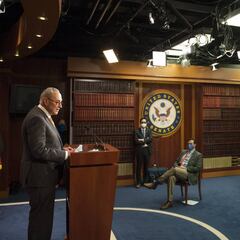Stimulus check: will there be a second round of payments in May 2020?
The first round of stimulus check payments were distributed by the Internal Revenue Services in April to help millions of Americans during the outbreak

The US house of Representatives managed to squeeze the Heroes Act through on Friday by 208 votes to 199, opening up the possibility of a second round of stimulus checks for US citizens during the ongoing coronavirus pandemic on the back of the $3 trillion relief package championed by House speaker Nancy Pelosi.
The Heroes Act will still face significant opposition from the Republican-controlled Senate and the White House but if the bill fails to pass into law after debate on the floor of the upper house, a consensus compromise is still expected to be reached between Democrats and Republicans to provide hard-hit Americans with a second round of financial support sometime during May.
More than $200 billion has already been paid out to US citizens in the form of stimulus check payments of $1,200 from the Internal Revenue Services (IRS). This came after the government approved a $2 trillion relief package in late March to counter the economic setbacks of the crisis, known as the CARES Act.
- What's in the Heroes Act, a proposed $3tn relief package?
- House of Representatives passes Heroes Act
- How does the Heroes Act affect immigrants?
- How the Heroes Act would affect student loans
$2 trillion aid package in first round
The IRS started sending the $1,200 payments as early as mid-April but as of mid-May not everyone who is eligible had received their check,
IRS opens up phone lines for stimulus check queries, adds 3,500 representatives.
You might have heard the payment called a 'recovery rebate', instead of a stimulus check. That’s because it’s technically a tax credit that is set to appear on the return you'll file for the 2020 tax year.
While tax rebates usually take effect after you file your taxes, the government has brought forward the credit to curb the impact Covid-19 has inflicted on American businesses and incomes, meaning Americans get the cash in their hands now. These stimulus checks may help those who have lost their job - with some questioning their right to stay at home - or are struggling financially in the face of lockdown.
Will there be a second round in May?
BREAKING: The House just passed the #HeroesAct to fund:
— Rep. Diana DeGette (@RepDianaDeGette) May 16, 2020
💰Cash payments to families
👩⚕️Hazard pay for essential workers
🏥Money for testing & tracing
💼Stronger unemployment benefits
🥫Expanded food assistance
🏠Rent & mortgage relief
The Senate must pass this bill immediately.
It has become a common question whether there will be a second round of stimulus checks in the month of May, with many arguing that $1,200 is unlikely to cover the expenses for people who have lost their jobs or have faced additional financial obstacles in the past weeks.
Financial technology firm SimplyWise found that 63% of Americans will require a second stimulus check within the next three months to pay bills.
“We could very well do a second round of direct payments,” President Donald Trump said while answering press questions earlier this month. “It is absolutely under serious consideration.” Recently however, Trump appears to have cooled on direct support for hard-working Americans, preferring to back other measures, such as payroll tax cuts. And the White House is said to be analysing a new $5,000 payment proposal with a difference.
With the Heroes Act having passed muster in the House, it remains to be seen if the Senate will follow suit.
Heroes act would expand eligibility for stimulus checks
See also:
- Where to claim unemployment benefits in the US: phone, online
- Stimulus check: Will IRS contact me? Do I need to contact IRS?
- Who needs to use the non-filer application?
- How to track status with Get My Payment IRS portal
- Stimulus check direct-deposit information: deadline today
Policies applied in the US to mitigate the Covid-19 economic crisis
The Coronavirus Aid, Relief and Economic Security (CARES) Act has been the mainstay of the Federal government's economic aid plan - totaling $2.3 trillion.
The CARES Act provided for $367 billion in loans and grants for small businesses; expansion of unemployment benefits to furloughed individuals, gig workers and freelancers; direct stimulus check payments to individuals; over $130 billion for the health care system; $500 billion of loans to large corporates; $150 billion to state and local governments.
The following is an overview timeline of the actions taken in response to the coronavirus pandemic in the US:
March 3 and March 15 - The Fed cuts interest rates in two emergency meetings on March 3 and March 15 (50 and 100 basis points respectively), taking the federal funds rate to 0-0.25%. It also cut the discount window rate by 150 basis points.
March 18 - The Fed rolls out its third emergency credit program in two days.
March 23 - The Fed promises unlimited, spending response to the crisis open-ended QE, including purchases of to near $3 trillion. corporate and municipal bonds.
March 27 - CARES Act signed into law
March 31 - The Fed broadens access to dollars with repo agreements for foreign central banks.
April 9 - The Fed rolls out $2.3 trillion to backstop 'Main Street' local governments and small and mid-sized businesses.
Related stories
April 27 - The Fed broadens its help for local governments, offering to buy bonds of up to three years' duration from counties with as few as 500,000 residents and cities with as few as 250,000 residents.
May 15 - US House of Representatives passes Heroes Act.
Live coverage of the coronavirus crisis
You can follow the latest developments in the coronavirus pandemic with our daily live blog. We also have a rolling feed dedicated to the United States right here.

